Manuale Bowers and Wilkins CCM20 Altoparlante
Hai bisogno di un manuale per il tuo Bowers and Wilkins CCM20 Altoparlante? Di seguito è possibile visualizzare e scaricare gratuitamente il manuale in PDF in italiano. Questo prodotto attualmente ha 5 domande frequenti, 0 commenti e ha 0 voti. Se questo non è il manuale che desideri, contattaci.
Il tuo prodotto è difettoso e il manuale non fornisce alcuna soluzione? Rivolgiti a un Repair Café per il servizio di riparazione gratuita.
Manuale
Loading…

Loading…
Valutazione
Facci sapere che cosa pensi della Bowers and Wilkins CCM20 Altoparlante valutando il prodotto. Vuoi condividere la tua esperienze con questo prodotto o porre una domanda? Ti preghiamo di lasciare un commento al fondo della pagina.Maggiori informazioni su questo manuale
Comprendiamo che sia bello avere un manuale cartaceo per i tuoi Bowers and Wilkins CCM20 Altoparlante. Puoi sempre scaricare il manuale dal nostro sito web e stamparlo tu stesso. Se desideri avere un manuale originale, ti consigliamo di contattare Bowers and Wilkins. Potrebbero essere in grado di fornire un manuale originale. Stai cercando il manuale del tuo Bowers and Wilkins CCM20 Altoparlante in un'altra lingua? Scegli la tua lingua preferita sulla nostra home page e cerca il numero del modello per vedere se è disponibile.
Specifiche
| Marca | Bowers and Wilkins |
| Modello | CCM20 |
| Categoria | Altoparlanti |
| Tipo di file | |
| Dimensione del file | 0.14 MB |
Tutti i manuali per Bowers and Wilkins Altoparlanti
Altri manuali di Altoparlanti
Domande frequenti su Bowers and Wilkins CCM20 Altoparlante
Il nostro team di supporto cerca informazioni utili sul prodotto e risposte alle domande più frequenti. Se trovi un’inesattezza nelle nostre domande frequenti, ti preghiamo di farcelo sapere utilizzando il nostro modulo di contatto.
Quale porta devo utilizzare se voglio collegare una cassa al televisore tramite HDMI? Verificato
Utilizzare la porta HDMI-ARC, appositamente pensata per collegare i dispositivi audio.
È stato utile (1363) Per saperne di piùCosa indicano le frequenze riferite al mio altoparlante? Verificato
Indica la gamma di frequenze che l'altoparlante può produrre. Una gamma più alta di frequenze fornirà una variazione più ampia del suono e il suono sarà di qualità migliore.
È stato utile (742) Per saperne di piùQuando il volume della musica è troppo alto? Verificato
Il suono superiore a 80 decibel (dB) può iniziare a danneggiare l’udito. Il suono superiore a 120 dB lo danneggia immediatamente. La gravità del danno è correlata alla frequenza e alla durata del suono.
È stato utile (433) Per saperne di piùIl segnale Bluetooth passa attraverso muri e soffitti? Verificato
Sì, il segnale Bluetooth passa attraverso muri e soffitti, a meno che non siano fatti di metallo. A seconda dello spessore e del materiale dei muri, il segnale potrebbe indebolirsi.
È stato utile (198) Per saperne di piùQual è la soglia massima di rumore sicura per i bambini? Verificato
L’udito dei bambini è più sensibile di quello degli adulti. Si consiglia pertanto di non esporre i bambini a rumori più alti di 85 dB. Esistono modelli speciali di auricolari appositi per bambini. In caso di altoparlanti o altre situazioni, si consiglia di fare attenzione che il rumore non superi quella soglia.
È stato utile (175) Per saperne di più










Partecipa alla conversazione su questo prodotto
Qui puoi condividere cosa pensi di Bowers and Wilkins CCM20 Altoparlante. Se hai una domanda, leggi prima attentamente il manuale. La richiesta di un manuale può essere effettuata utilizzando il nostro modulo di contatto.